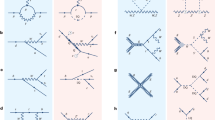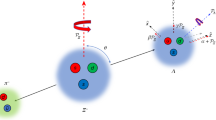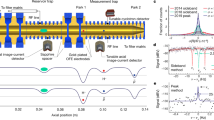Abstract
New fundamental particles at the mass scale of a few TeV c–2 could account for observed phenomena that cannot be explained by the standard model (SM) of particle physics, including the microscopic origin of dark matter and the macroscopic imbalance of matter over antimatter in the Universe. However, no beyond-the-SM (BSM) particles at the TeV scale have yet been detected at the Large Hadron Collider (LHC). With recent innovations, searches for time-reversal symmetry (T) violation through low-energy precision measurements of electric dipole moments (EDMs) of atoms and molecules have attained the sensitivity to detect indirect signatures of certain particles with masses of more than 10 TeV c–2. In this Perspective, we discuss recent developments in the measurement and interpretation of EDMs, and assess proposed techniques for future experiments that could push experimental limits on T-violating BSM physics to the PeV scale.
This is a preview of subscription content, access via your institution
Access options
Access Nature and 54 other Nature Portfolio journals
Get Nature+, our best-value online-access subscription
$29.99 / 30 days
cancel any time
Subscribe to this journal
Receive 12 digital issues and online access to articles
$99.00 per year
only $8.25 per issue
Buy this article
- Purchase on Springer Link
- Instant access to full article PDF
Prices may be subject to local taxes which are calculated during checkout





Similar content being viewed by others
References
CMS Collaboration. Observation of a new boson at a mass of 125 GeV with the CMS experiment at the LHC. Phys. Lett. B 716, 30–61 (2012).
ATLAS Collaboration. Observation of a new particle in the search for the standard model Higgs boson with the ATLAS detector at the LHC. Phys. Lett. B 716, 1–29 (2012).
Hanneke, D., Fogwell, S. & Gabrielse, G. New measurement of the electron magnetic moment and the fine structure constant. Phys. Rev. Lett. 100, 120801 (2008).
Blumenthal, G. R., Faber, S. M., Primack, J. R. & Rees, M. J. Formation of galaxies and large-scale structure with cold dark matter. Nature 311, 517–525 (1984).
Feng, J. L. Naturalness and the status of supersymmetry. Annu. Rev. Nucl. Part. Sci. 63, 351–382 (2013).
Dine, M. & Kusenko, A. Origin of the matter–antimatter asymmetry. Rev. Mod. Phys. 76, 1–30 (2004).
Sakharov, A. D. Violation of CP-invariance, C-asymmetry, and baryon asymmetry of the Universe. JETP Lett. 5, 24–27 (1967).
Branco, G. C., Lavoura, L. & Silva, J. P. CP violation. Int. Ser. Monogr. Phys. 103, 1–536 (1999).
Alavi-Harati, A. et al. Measurements of direct CP violation, CPT symmetry, and other parameters in the neutral kaon system. Phys. Rev. D 67, 012005 (2003).
Abe, K. et al. Observation of large CP violation in the neutral B meson system. Phys. Rev. Lett. 87, 091802 (2001).
Engel, J., Ramsey-Musolf, M. J. & Van Kolck, U. Electric dipole moments of nucleons, nuclei, and atoms: the standard model and beyond. Prog. Part. Nucl. Phys. 71, 21–74 (2013).
Khriplovich, I. B. & Lamoreaux, S. K. CP Violation Without Strangeness (Springer, 1997).
Safronova, M. S. et al. Search for new physics with atoms and molecules. Rev. Mod. Phys. 90, 025008 (2017).
Andreev, V. et al. Improved limit on the electric dipole moment of the electron. Nature 562, 355–360 (2018).
DeMille, D., Doyle, J. M. & Sushkov, A. O. Probing the frontiers of particle physics with tabletop-scale experiments. Science 357, 990–994 (2017).
Feng, J. L. Dark matter candidates from particle physics and methods of detection. Annu. Rev. Astron. Astrophys. 48, 495–545 (2010).
Abel, C. et al. Search for axionlike dark matter through nuclear spin precession in electric and magnetic fields. Phys. Rev. X 7, 041034 (2017).
Campbell, S. L. et al. A Fermi-degenerate three-dimensional optical lattice clock. Science 358, 90–94 (2017).
Chupp, T., Fierlinger, P., Ramsey-Musolf, M. & Singh, J. Electric dipole moments of the atoms, molecules, nuclei and particles. Rev. Mod. Phys. 91, 015001 (2017).
Appelquist, T. & Carazzone, J. Infrared singularities and massive fields. Phys. Rev. D 11, 2856–2861 (1975).
Grzadkowski, B., Iskrzyński, M., Misiaka, M. & Rosieka, J. Dimension-six terms in the standard model Lagrangian. J. High Energy Phys. 2010, 85 (2010).
Chupp, T. & Ramsey-Musolf, M. Electric dipole moments: a global analysis. Phys. Rev. C 91, 035502 (2014).
Fleig, T. & Jung, M. Model-independent determinations of the electron EDM and the role of diamagnetic atoms. J. High Energy Phys. 2018, 12 (2018).
DekensW., De VriesJ. Jung M. & Vos K. K. The phenomenology of electric dipole moments in models of scalar leptoquarks. J. High Energy Phys. 1901, 69 (2019).
Inoue, S., Ramsey-Musolf, M. J. & Zhang, Y. CP-violating phenomenology of flavor conserving two Higgs doublet models. Phys. Rev. D 89, 115023 (2014).
Cesarotti, C., Lu, Q., Nakai, Y., Parikh, A. & Reece, M. Interpreting the electron EDM constraint. Preprint at https://arxiv.org/abs/1810.07736 (2018).
Schiff, L. I. Measurability of nuclear electric dipole moments. Phys. Rev. 132, 2194–2200 (1963).
Sandars, P. G. H. The electric dipole moment of an atom. Phys. Lett. 14, 194–196 (1965).
Commins, E. D., Jackson, J. D. & DeMille, D. P. The electric dipole moment of the electron: an intuitive explanation for the evasion of Schiff’s theorem. Am. J. Phys. 75, 532–536 (2007).
Hinds, E. A. Testing time reversal symmetry using molecules. Phys. Scr. T70, 34–41 (1997).
Flambaum, V. V. Enhanced nuclear Schiff moment and time reversal violation in 229Th-containing molecules. Preprint at https://arxiv.org/abs/1808.03629 (2018).
Sushkov, O. P. & Flambaum, V. V. Parity breaking effects in diatomic molecules. Sov. Phys. JETP 48, 608–611 (1978).
Haxton, W. C. & Henley, E. M. Enhanced T-nonconserving nuclear moments. Phys. Rev. Lett. 51, 1937–1940 (1983).
Sushkov, P., Flambaum, V. V. & Khriplovich, I. B. Possibility of investigating P- and T-odd nuclear forces in atomic and molecular experiments. JETP 60, 873–883 (1984).
Griffith, W. C. et al. Improved limit on the permanent electric dipole moment of 199Hg. Phys. Rev. Lett. 102, 872–874 (2009).
Bishof, M. et al. Improved limit on the 225Ra electric dipole moment. Phys. Rev. C 94, 025501 (2016).
Hudson, J. J. et al. Improved measurement of the shape of the electron. Nature 473, 493–496 (2011).
Ramsey, N. F. A molecular beam resonance method with separated oscillating fields. Phys. Rev. 78, 695–699 (1950).
Baron, J. et al. Order of magnitude smaller limit on the electric dipole moment of the electron. Science 343, 269–272 (2014).
Graner, B., Chen, Y., Lindahl, E. G. & Heckel, B. R. Reduced limit on the permanent electric dipole moment of 199Hg. Phys. Rev. Lett. 116, 161601 (2016).
Itano, W. M. et al. Quantum projection noise: population fluctuations in two-level systems. Phys. Rev. A 47, 3554–3570 (1993).
Cairncross, W. B. et al. Precision measurement of the electron’s electric dipole moment using trapped molecular ions. Phys. Rev. Lett. 119, 153001 (2017).
Kuchler, F. et al. A new search for the atomic EDM of 129Xe at FRM-II. Hyperfine Interact. 237, 1–5 (2016).
Tardiff, E. R. et al. The radon EDM apparatus. Hyperfine Interact. 225, 197–206 (2014).
Norrgard, E. B. et al. Hyperfine structure of the B3Π1 state and predictions of optical cycling behavior in the X→B transition of TlF. Phys. Rev. A 95, 062506 (2017).
Dobaczewski, J. & Engel, J. Nuclear time-reversal violation and the schiff moment of 225Ra. Phys. Rev. Lett. 94, 232502 (2005).
Auerbach, N., Flambaum, V. V. & Spevak, V. Collective T- and P-odd electromagnetic moments in nuclei with octupole deformations. Phys. Rev. Lett. 76, 4316–4319 (1996).
Flambaum, V. V. & Zelevinsky, V. G. Enhancement of nuclear Schiff moments and time-reversal violation in atoms due to soft nuclear octupole vibrations. Phys. Rev. C 68, 035502 (2003).
Parker, R. H. et al. First measurement of the atomic electric dipole moment of 225Ra. Phys. Rev. Lett. 114, 233002 (2015).
Nagourney, W., Sandberg, J. & Dehmelt, H. Shelved optical electron amplifier: observation of quantum jumps. Phys. Rev. Lett. 56, 2797–2799 (1986).
Bollen, G. FRIB — Facility for Rare Isotope Beams. AIP Conf. Proc. 1224, 432–441 (2010).
Regan, B. C., Commins, E. D., Schmidt, C. J. & DeMille, D. New limit on the electron electric dipole moment. Phys. Rev. Lett. 88, 718051–718054 (2002).
Hutzler, N. R., Lu, H. & Doyle, J. M. The buffer gas beam: an intense, cold, and slow source for atoms and molecules. Chem. Rev. 112, 4803–4827 (2012).
West, E. P. A Thermochemical Cryogenic Buffer Gas Beam Source of ThO for Measuring the Electric Dipole Moment of the Electron. PhD thesis, Harvard Univ. (2017).
Baron, J. et al. Methods, analysis, and the treatment of systematic errors for the electron electric dipole moment search in thorium monoxide. New J. Phys. 19, 73029–73068 (2017).
Lasner, Z. Order-of-Magnitude-Tighter Bound on the Electron Electric Dipole Moment. PhD thesis, Yale Univ. (2019).
Lasner, Z. & Demille, D. Statistical sensitivity of phase measurements via laser-induced fluorescence with optical cycling detection. Phys. Rev. A 98, 053823 (2018).
Cairncross, W. B. Searching for time-reversal symmetry with molecular ions: quantum state control and photofragment imaging. PhD thesis, Univ. Colorado (2019).
Zhu, K., Solmeyer, N., Tang, C. & Weiss, D. S. Absolute polarization measurement using a vector light shift. Phys. Rev. Lett. 111, 243005–243006 (2013).
Inoue, T. et al. Experimental search for the electron electric dipole moment with laser cooled francium atoms. Hyperfine Interact. 231, 157–162 (2015).
The NL-eEDM Collaboration. Measuring the electric dipole moment of the electron in BaF. Eur. Phys. J. D 72, 197 (2018).
Norrgard, E. B. et al. Hyperfine structure of the B 3Π1 state and predictions of optical cycling behavior in the X→B transition of TlF. Phys. Rev. A 95, 062506 (2017).
Flambaum, V. V., Demille, D. & Kozlov, M. G. Time-reversal symmetry violation in molecules induced by nuclear magnetic quadrupole moments. Phys. Rev. Lett. 113, 103003 (2014).
Fleig, T. TaO+ as a candidate molecular ion for searches of physics beyond the standard model. Phys. Rev. A 95, 022504 (2017).
Skripnikov, L. V., Titov, A. V. & Flambaum, V. V. Enhanced effect of CP-violating nuclear magnetic quadrupole moment in a HfF+ molecule. Phys. Rev. A 95, 1220 (2017).
Kozyryev, I. & Hutzler, N. R. Precision measurement of time-reversal symmetry violation with laser-cooled polyatomic molecules. Phys. Rev. Lett. 119, 133002–133006 (2017).
Cossel, K. C. Techniques in Molecular Spectroscopy: From Broad Bandwidth to High Resolution. PhD thesis, Univ. of Colorado, Boulder (2014).
Zhou, Y. et al. Visible and ultraviolet laser spectroscopy of ThF. J. Mol. Spectrosc. 358, 1–6 (2019).
Collopy, A. L. et al. 3D Magneto-optical trap of yttrium monoxide. Phys. Rev. Lett. 121, 213201 (2018).
Anderegg, L. et al. Radio frequency magneto-optical trapping of CaF with high density. Phys. Rev. Lett. 119, 103201 (2017).
Barry, J. F., McCarron, D. J., Norrgard, E. B., Steinecker, M. H. & DeMille, D. Magneto-optical trapping of a diatomic molecule. Nature 512, 286–289 (2014).
Truppe, S. et al. Molecules cooled below the Doppler limit. Nat. Phys. 13, 1173–1176 (2017).
Lim, J. et al. Laser cooled YbF molecules for measuring the electron’s electric dipole moment. Phys. Rev. Lett. 120, 123201 (2018).
Tarbutt, M. R., Sauer, B. E., Hudson, J. J. & Hinds, E. A. Design for a fountain of YbF molecules to measure the electron’s electric dipole moment. New J. Phys. 15, 53018–53034 (2013).
DeMille, D. Search for the electric dipole moment of the electron using metastable PbO. AIP Conf. Proc. 596, 72–83 (2001).
Meyer, E. R., Bohn, J. L. & Deskevich, M. P. Candidate molecular ions for an electron electric dipole moment experiment. Phys. Rev. A 73, 62108–62110 (2006).
Nakhate, S., Steimle, T. C., Pilgram, N. H. & Hutzler, N. R. The pure rotational spectrum of YbOH. Chem. Phys. Lett. 715, 105–108 (2018).
Braverman, B., Kawasaki, A. & Vuletic, V. Impact of non-unitary spin squeezing on atomic clock performance. New J. Phys. 20, 103019 (2018).
Huelga, S. F. et al. Improvement of frequency standards with quantum entanglement. Phys. Rev. Lett. 79, 3865–3868 (1997).
Pezzè, L., Smerzi, A., Oberthaler, M. K., Schmied, R. & Treutlein, P. Quantum metrology with nonclassical states of atomic ensembles. Rev. Mod. Phys. 90, 035005 (2016).
Heidenreich, B. J. et al. Limit on the electron electric dipole moment in gadolinium-iron garnet. Phys. Rev. Lett. 95, 253004 (2005).
Eckel, S., Sushkov, A. O. & Lamoreaux, S. K. Limit on the electron electric dipole moment using paramagnetic ferroelectric Eu0.5Ba0.5TiO3. Phys. Rev. Lett. 109, 193003 (2012).
Kozlov, M. G. & Derevianko, A. Proposal for a sensitive search for the electric dipole moment of the electron with matrix-isolated radicals. Phys. Rev. Lett. 97, 63001 (2006).
Vutha, A. C., Horbatsch, M. & Hessels, E. A. Oriented polar molecules in a solid inert-gas matrix: a proposed method for measuring the electric dipole moment of the electron. Atoms 6, 3–10 (2017).
Vutha, A. C., Horbatsch, M. & Hessels, E. A. Orientation-dependent hyperfine structure of polar molecules in a rare-gas matrix: a scheme for measuring the electron electric dipole moment. Phys. Rev. A 98, 032513 (2018).
Kozyryev, I., Baum, L., Matsuda, K. & Doyle, J. M. Proposal for laser cooling of complex polyatomic molecules. ChemPhysChem 17, 3641–3648 (2016).
Tureanu, A. CPT and Lorentz invariance: their relation and violation. J.Phys. Conf. Ser. 474, 12031 (2013).
Purcell, E. M. & Ramsey, N. F. On the possibility of electric dipole moments for elementary particles and nuclei. Phys. Rev. 78, 807 (1950).
Smith, J. H., Purcell, E. M. & Ramsey, N. F. Experimental measurement to the electric dipole moment of the neutron. Phys. Rev. 108, 120–122 (1957).
Lee, T. D. & Yang, C. N. Question of parity conservation in weak interactions. Phys. Rev. 104, 254–258 (1956).
Wu, C. S., Ambler, E., Hayward, R. W., Hoppes, D. D. & Hudson, R. P. Experimental test of parity conservation in beta decay. Phys. Rev. 105, 1413–1415 (1957).
Acknowledgements
The authors thank E. A. Cornell, N. R. Hutzler, A. Vutha, E. A. Hessels, C. D. Panda and D. DeMille for valuable discussions.
Author information
Authors and Affiliations
Contributions
The authors contributed equally to all aspects of the article.
Corresponding author
Ethics declarations
Competing interests
The authors declare no competing interests.
Additional information
Publisher’s note
Springer Nature remains neutral with regard to jurisdictional claims in published maps and institutional affiliations.
Rights and permissions
About this article
Cite this article
Cairncross, W.B., Ye, J. Atoms and molecules in the search for time-reversal symmetry violation. Nat Rev Phys 1, 510–521 (2019). https://doi.org/10.1038/s42254-019-0080-0
Accepted:
Published:
Issue Date:
DOI: https://doi.org/10.1038/s42254-019-0080-0
This article is cited by
-
Quantum sensing for particle physics
Nature Reviews Physics (2024)
-
Saturated absorption spectroscopy of buffer-gas-cooled Barium monofluoride molecules
Frontiers of Physics (2022)
-
Large-Area TKIDs for Charged Particle Detection
Journal of Low Temperature Physics (2022)
-
Tuning of dipolar interactions and evaporative cooling in a three-dimensional molecular quantum gas
Nature Physics (2021)



